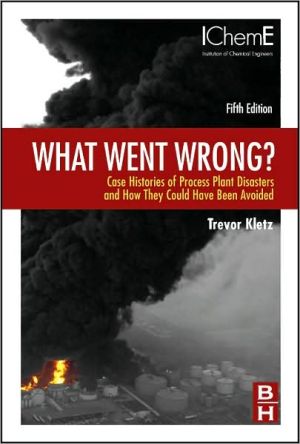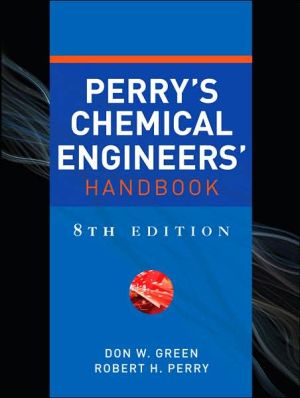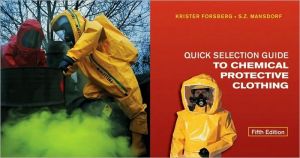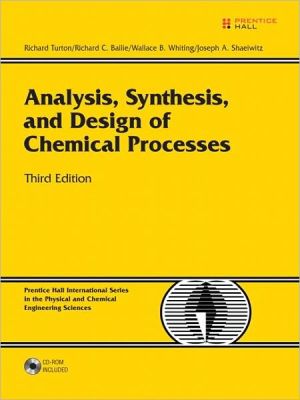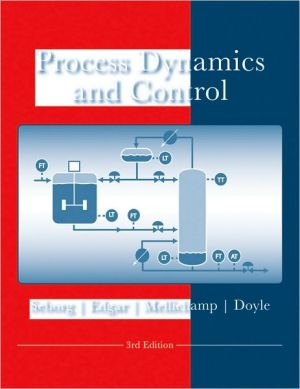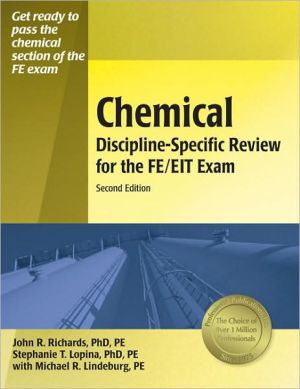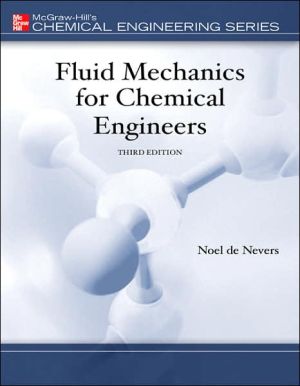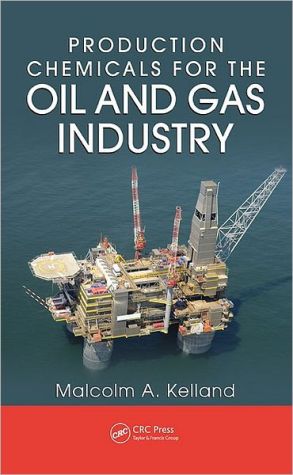Fluid Mechanics for Chemical Engineers with Microfluidics and CFD
The Chemical Engineer's Practical Guide to Contemporary Fluid Mechanics\ Since most chemical processing applications are conducted either partially or totally in the fluid phase, chemical engineers need a strong understanding of fluid mechanics. Such knowledge is especially valuable for solving problems in the biochemical, chemical, energy, fermentation, materials, mining, petroleum, pharmaceuticals, polymer, and waste-processing industries.\ Fluid Mechanics for Chemical Engineers, Second...
Search in google:
The Chemical Engineer's Practical Guide to Contemporary Fluid Mechanics Since most chemical processing applications are conducted either partially or totally in the fluid phase, chemical engineers need a strong understanding of fluid mechanics. Such knowledge is especially valuable for solving problems in the biochemical, chemical, energy, fermentation, materials, mining, petroleum, pharmaceuticals, polymer, and waste-processing industries.Fluid Mechanics for Chemical Engineers, Second Edition, with Microfluidics and CFD, systematically introduces fluid mechanics from the perspective of the chemical engineer who must understand actual physical behavior and solve real-world problems. Building on a first edition that earned Choice Magazine's Outstanding Academic Title award, this edition has been thoroughly updated to reflect the field's latest advances.This second edition contains extensive new coverage of both microfluidics and computational fluid dynamics, systematically demonstrating CFD through detailed examples using FlowLab and COMSOL Multiphysics. The chapter on turbulence has been extensively revised to address more complex and realistic challenges, including turbulent mixing and recirculating flows.Part I offers a clear, succinct, easy-to-follow introduction to macroscopic fluid mechanics, including physical properties; hydrostatics; basic rate laws for mass, energy, and momentum; and the fundamental principles of flow through pumps, pipes, and other equipment. Part II turns to microscopic fluid mechanics, which covers Differential equations of fluid mechanics Viscous-flow problems, some including polymer processing Laplace's equation, irrotational, and porous-media flows Nearly unidirectional flows, from boundary layers to lubrication, calendering, and thin-film applications Turbulent flows, showing how the k/ε method extends conventional mixing-length theory Bubble motion, two-phase flow, and fluidization Non-Newtonian fluids, including inelastic and viscoelastic fluids Microfluidics and electrokinetic flow effects including electroosmosis, electrophoresis, streaming potentials, and electroosmotic switching Computational fluid mechanics with FlowLab and COMSOL MultiphysicsFluid Mechanics for Chemical Engineers, Second Edition, with Microfluidics and CFD, includes 83 completely worked practical examples, several of which involve FlowLab and COMSOL Multiphysics. There are also 330 end-of-chapter problems of varying complexity, including several from the University of Cambridge chemical engineering examinations. The author covers all the material needed for the fluid mechanics portion of the Professional Engineer's examination.The author's Web site, www.engin.umich.edu/~fmche/, provides additional notes on individual chapters, problem-solving tips, errata, and more. Booknews A text for undergraduates and first-year graduate students, offering four chapters on macroscopic or relatively large-scale phenomena, followed by eight chapters on microscopic or relatively small-scale phenomena. Provides numerous real-world examples and chapter problems of increasing complexity, including several from the University of Cambridge chemical engineering exams, and covers all the material necessary to pass the fluid mechanics portion of the Professional Engineer's exam. Annotation c. by Book News, Inc., Portland, Or.
This text has evolved from a need for a single volume that embraces a wide range of topics in fluid mechanics. The material consists of two parts—four chapters on macroscopic or relatively large-scale phenomena, followed by ten chapters on microscopic or relatively small-scale phenomena. Throughout, I have tried to keep in mind topics of industrial importance to the chemical engineer. The scheme is summarized in the following list of chapters.\ \ Part I—Macroscopic Fluid Mechanics\ 1. Introduction to Fluid Mechanics\ 2. Mass, Energy, and Momentum Balances\ 3. Fluid Friction in Pipes\ 4. Flow in Chemical Engineering Equipment\ \ \ Part II—Microscopic Fluid Mechanics\ 5. Differential Equations of Fluid Mechanics\ 6. Solution of Viscous-Flow Problems\ 7. Laplace's Equation, Irrotational and Porous-Media Flows\ 8. Boundary-Layer and Other Nearly Unidirectional Flows\ 9. Turbulent Flow\ 10. Bubble Motion, Two-Phase Flow, and Fluidization\ 11. Non-Newtonian Fluids\ 12. Microfluidics and Electrokinetic Flow Effects\ 13. An Introduction to Computational Fluid Dynamics and FlowLab\ 14. COMSOL (FEMLAB) Multi-physics for Solving Fluid Mechanics Problems\ \ In our experience, an undergraduate fluid mechanics course can be based on Part I plus selected parts of Part II, and a graduate course can be based on much of Part II, supplemented perhaps by additional material on topics such as approximate methods and stability.\ Second edition. I have attempted to bring the book up to date by the major addition of Chapters 12, 13, and 14—one on microfluidics and two on CFD (computational fluid dynamics). The choice of software for the CFD presented a difficulty; for various reasons, I selected FlowLab and COMSOL Multiphysics, but there was no intention of "promoting" these in favor of other excellent CFD programs.1 The use of CFD examples in the classroom really makes the subject come "alive," because the previous restrictive necessities of "nice" geometries and constant physical properties, etc., can now be lifted. Chapter 9, on turbulence, has also been extensively rewritten; here again, CFD allows us to venture beyond the usual flow in a pipe or between parallel plates and to investigate further practical situations such as turbulent mixing and recirculating flows.\ Example problems. There is an average of about six completely worked examples in each chapter, including several involving COMSOL (dispersed throughout Part II) and FlowLab (all in Chapter 13). The end of each example is marked by a small, hollow square. All the COMSOL examples have been run on a Macintosh G4 computer using FEMLAB 3.1, but have also been checked on a PC; those using a PC or other releases of COMSOL/FEMLAB may encounter slightly different windows than those reproduced here. The format for each COMSOL example is: (a) problem statement, (b) details of COMSOL implementation, and (c) results and discussion (however, item (b) can easily be skipped for those interested only in the results).\ The numerous end-of-chapter problems have been classified roughly as easy (E), moderate (M), or difficult/lengthy (D). The University of Cambridge has given permission—kindly endorsed by Professor J.F. Davidson, F.R.S.—for several of their chemical engineering examination problems to be reproduced in original or modified form, and these have been given the additional designation of "(C)".\ Further information. The website http://www.engin.umich.edu/~fmche is maintained as a "bulletin board" for giving additional information about the book—hints for problem solutions, errata, how to contact the authors, etc.—as proves desirable. My own Internet address is wilkes@umich.edu. The text was composed on a Power Macintosh G4 computer using the TEXtures "typesetting" program. Eleven-point type was used for the majority of the text. Most of the figures were constructed using MacDraw Pro, Excel, and KaleidaGraph.\ Professor Terence Fox, to whom this book is dedicated, was a Cambridge engineering graduate who worked from 1933 to 1937 at Imperial Chemical Industries Ltd., Billingham, Yorkshire. Returning to Cambridge, he taught engineering from 1937 to 1946 before being selected to lead the Department of Chemical Engineering at the University of Cambridge during its formative years after the end of World War II. As a scholar and a gentleman, Fox was a shy but exceptionally brilliant person who had great insight into what was important and who quickly brought the department to a preeminent position. He succeeded in combining an industrial perspective with intellectual rigor. Fox relinquished the leadership of the department in 1959, after he had secured a permanent new building for it (carefully designed in part by himself).\ Fox was instrumental in bringing Peter Danckwerts, Kenneth Denbigh, John Davidson, and others into the department. He also accepted me in 1956 as a junior faculty member, and I spent four good years in the CambridgeUniversity Department of Chemical Engineering. Danckwerts subsequently wrote an appreciation2 of Fox's talents, saying, with almost complete accuracy: "Fox instigated no research and published nothing." How times have changed—today, unless he were known personally, his résumé would probably be cast aside and he would stand little chance of being hired, let alone of receiving tenure! However, his lectures, meticulously written handouts, enthusiasm, genius, and friendship were a great inspiration to me, and I have much pleasure in acknowledging his positive impact on my career.\ James O. Wilkes August 18, 2005\ 1. The software name "FEMLAB" was changed to "COMSOL Multiphysics" in September 2005, the first release under the new name being COMSOL 3.2.\ 2. P.V. Danckwerts, "Chemical engineering comes to Cambridge," The Cambridge Review, pp. 53-55, February28, 1983.
PrefaceCh. 1Introduction to Fluid MechanicsCh. 2Mass, Energy, and Momentum BalancesCh. 3Fluid Friction in PipesCh. 4Flow in Chemical Engineering EquipmentCh. 5Differential Equations of Fluid MechanicsCh. 6Solution of Viscous-Flow ProblemsCh. 7Laplace's Equation for Irrotational and Porous Medium FlowsCh. 8Boundary-Layer and other Nearly Unidirectional FlowsCh. 9Turbulent FlowCh. 10Bubble Motion, Two-Phase Flow, and FluidizationCh. 11Non-Newtonian FluidsCh. 12The Matlab PDE Toolbox for Solving Some Fluid Mechanics ProblemsApp. AUseful Mathematical RelationshipsApp. BAnswers to the True/False AssertionsIndexThe Authors
\ BooknewsA text for undergraduates and first-year graduate students, offering four chapters on macroscopic or relatively large-scale phenomena, followed by eight chapters on microscopic or relatively small-scale phenomena. Provides numerous real-world examples and chapter problems of increasing complexity, including several from the University of Cambridge chemical engineering exams, and covers all the material necessary to pass the fluid mechanics portion of the Professional Engineer's exam. Annotation c. by Book News, Inc., Portland, Or.\ \

